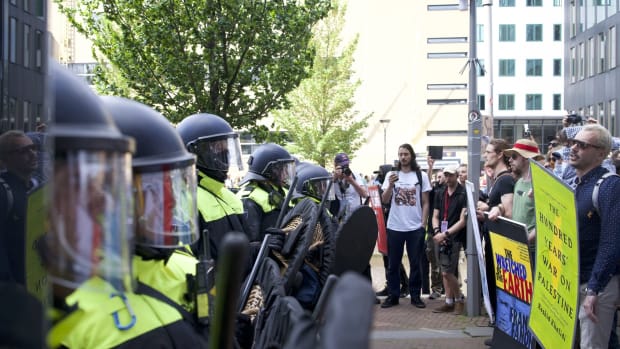
UvA administration made (judgement) errors at May 2024 demonstrations
The UvA Executive Board has commissioned an external evaluation of the large scale pro-Palestina demonstrations that took place at the UvA in May 2024. The Board itself does not come off too well, it appears.“Empathy, showing emotions and understanding concerns generally helps, but that was little visible from the Board.”
Anyone who thinks that the large-scale demonstrations and protests at the UvA only began in May 2024 is wrong: smaller demonstrations and protests had been going on for some time, including at the AUC, modelled on the demonstrations on campuses in the US. When things came to a head at the UvA on 6 May, a strategic approach “from a central point of control” would have been appropriate, the consultancy firm Berenschot wrote in an analysis of the events, that has been published by the UvA. But that central approach was initially not taken. With major consequences. “In retrospect, the Executive Board underestimated the impact of the situation in the Middle East on the University of Amsterdam, even though there were indications of large-scale protests,” according to Berenschot.
It is just one of the rather painful conclusions that Berenschot draws in response to the disturbances and demonstrations in May of last year and the UvA’s response to them. These pro-Palestinian demonstrations turned the entire UvA upside down in a short period of time and were of unprecedented size and ferocity.
One decision maker
Naturally, a crisis team was activated immediately on 6 May, but it initially remained organised in a fairly decentralised manner, analogous to the decentralised approach that had previously been chosen for smaller disturbances at the AUC and REC. Berenschot believes that this decentralised approach – involving many officials – was not a good plan in this crisis. “In crises, a centralised approach is needed for speed and clarity in decision-making”. It is therefore necessary to “appoint a single decision-maker to make decisions during the crisis, ” Berenschot says.
There seems to have been a lack of internal and external communication in the first two (crucial) weeks. Mayor Halsema, responsible for public order in the city, also notes this: she is “not satisfied with the contact with the University of Amsterdam and has trouble reaching the Executive Board,” writes Berenschot. There also seems to have been a lack of manpower, which probably also had to do with the holiday period: the chair of the Board was still on holiday at the start of the crisis, as was one of the spokespersons. Berenschot concludes in any case: “A well-considered and pre-arranged relief schedule was lacking in the first two weeks.” In addition, there was “too little and too late” internal communication. “The wider UvA community was kept informed to a limited extent by the UvA itself.”
Police
Talks soon began between the Executive Board and the demonstrators, but they yielded very little. “The students’ demands were firm and the substantive position of the Executive Board was that the demands could not be met.” The Executive Board and the demonstrators were thus pitted against each other, which only served to escalate the situation, exacerbated by the police deployment and the violence associated with it. The UvA was not responsible for this, but many demonstrators blamed the university. The violence used was one of the reasons why the Central Student Council passed a motion of no confidence against the Executive Board.
Interview with rector Verbeek
According to Berenschot, the UvA Board’s media performance did not win any prizes either. The performance of rector magnificus Peter-Paul Verbeek in a (Dutch) broadcast of Nieuwsuur on 9 May was not well received, “partly because his appearance in the interview did not match the message”. Anyone who watches the broadcast will see a kindly smiling rector who does not seem to recognise the seriousness of the situation when he mentions having negotiated with demonstrators who were wearing face coverings, which is against UvA rules. Presenter Mariëlle Tweebeeke could not believe her ears when she heard it. The impact of the media appearance “did not seem to have been correctly assessed,” according to Berenschot.
Central intervention
The Executive Board has responded to the Berenschot report in a letter to the joint participation bodies of the UvA, the Central Student Council (CSR) and the Central Works Council (COR). By the way, the Executive Board has undergone a change in membership since the May riots: Geert ten Dam resigned on 1 June and was succeeded by Edith Hooge. Ten Dam’s resignation had nothing to do with the riots, but with the end of her second term as chair.
In its letter to the joint participation bodies, the Executive Board writes that it recognises Berenschot’s conclusion that decentralised crisis management is “not suitable for every calamity or crisis”. The Executive Board writes that in the event of a calamity or crisis, “a central crisis team will be formed more quickly with clear administrative responsibility”.
Triangle
The Executive Board also writes that agreements have been made “for regular meetings” with the Mayor-Police-Public Prosecutor’s Office, the so-called Triangle “so that lines of communication remain short, which enables us to switch gears more quickly and work together better”. The UvA Board recognises that internal communication from the university “should have been better,” although the Board would like to emphasise that they worked hard to keep everyone as well informed as possible. The Executive Board also writes that they will adopt Berenschot’s recommendation to broaden a discussion without waiting too long. “Demonstrations and actions can put topics on the agenda. It is then important to also listen to the voices of students and staff who do not always make themselves heard loudly; it is precisely these diverse perspectives from the entire university community that are essential for representative decision-making.”
The CSR and COR have not yet responded to the letter of the Board.

